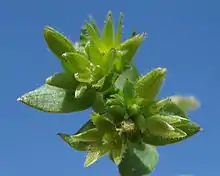Stellaria pallida
Stellaria pallida, commonly known as lesser chickweed,[1] is an annual herbaceous plant in the flowering plant family Caryophyllaceae. It is native to Europe and is an introduced species in North America.
| Stellaria pallida | |
|---|---|
 | |
| Scientific classification | |
| Kingdom: | Plantae |
| Clade: | Tracheophytes |
| Clade: | Angiosperms |
| Clade: | Eudicots |
| Order: | Caryophyllales |
| Family: | Caryophyllaceae |
| Genus: | Stellaria |
| Species: | S. pallida |
| Binomial name | |
| Stellaria pallida | |
| Synonyms | |
|
Alsine pallida Dumort. | |
Taxonomy
Stellaria pallida forms part of a complex that also includes S. media and S. neglecta.
It is supposed that Stellaria pallida is the species that was described by Ucria in 1796 as Alsine petala. In 1828, Du Mortier, describing a form found in Belgium, applied the name Alsine pallida, which Piré (1863) transferred to the genus Stellaria.[2]
The taxonomic status of Stellaria pallida (Dumort.) Piré has remained confused. Dandy (1958) and Clapham, Tutin and Warburg (1962) adopted this name,[3][4] but while Clapham et al. treated S. apetala Ucria as a synonym, Dandy considered this to be a synonym of S. media L., as also did Chater and Heywood.[5] Whitehead and Sinha, having failed to locate any specimens matching the description in the Flora Europaea, concluded that S. apetala Ucria or S. apetala auct. can be regarded as synonyms of S. pallida (Dumort.) Piré.[2] This conclusion is now reflected in the online version of the Flora Europaea.[6]
Description
Stellaria pallida is a much-branched herb, generally yellowish-green in colour. The stems are prostrate, usually 10–20 cm long, though some can reach 40 cm, and glabrous, with a single row of hairs between each pair of nodes. Leaves are pale-green and ovate, up to 1.5 cm long and usually less than 0.7 cm broad; proximal leaves have a short stalk, distal leaves are sessile.[4][7]
The flowers are borne in terminal inflorescences of between 3 and 6 cymes. Flowers are small, 2–3 mm in diameter, and never open widely. There are four or five green sepals, lanceolate and 2–3.5 mm long. Petals are usually absent, or, if present, are minute. There are usually between one and three stamens, sometimes none, with grey-violet anthers, and three styles.[4][7][8]
The numerous seeds are pale yellowish-brown, occasionally darker, 0.6–0.8 mm in diameter, with prominent small, blunt tubercles.[4][7][9]
Stellaria pallida is self-pollinating and, because the flowers do not open widely, is often cleistogamous.[4]
Distribution
Stellaria pallida has a widespread, though local, distribution across Europe, from southern Spain and the Mediterranean islands to Lapland, and from the British Isles to Ukraine.[9][10] In North America it is found as an introduced species from Ontario, Canada, to Mexico and throughout the United States, from the east coast (Virginia, North and South Carolina, and Florida) to the west coast (California and Washington).[7][8]
Habitat
Stellaria pallida is usually found on coastal sand dunes, in sandy waste places,[7] or on cultivated sandy soils.[4] In Europe it is often found growing under the shade of Scots Pine in woodland on light glacial sands.[2]
Similar species
The apetalous form of Stellaria media, var. apetala Gaudin, and S. pallida are superficially similar and are easily confused. A combination of morphological characters is usually required to separate them, the most useful including overall colour (media is darker green), size of leaves and sepals (media is larger), number of stamens (pallida has 1-3, media has 3-10), colour of anthers (grey-violet in pallida, red-violet in media), and colour and size of seeds (yellowish-brown, ≤ 0.8 mm in pallida; dark-reddish-brown and ≥ 0.9 mm in media).[8]
References
- "BSBI List 2007". Botanical Society of Britain and Ireland. Archived from the original (xls) on 2015-01-25. Retrieved 2014-10-17.
- Whitehead, F. H.; R. P. Sinha (October 1967). "Taxonomy and Taximetrics of Stellaria media (L.) Vill., S. neglecta Weihe and S. pallida (Dumort.) Pire". New Phytologist. Blackwell Publishing. 66 (4): 769–784. doi:10.1111/j.1469-8137.1967.tb05444.x. JSTOR 2430464.
- Dandy, James Edgar (1958). List of British Vascular Plants. London: British Museum.
- Clapham, Arthur Roy; Tutin, Thomas Gaskell; Warburg, E F (1962). Flora of the British Isles (2nd ed.). Cambridge University Press. ISBN 0-521-26962-8.
- Chater, A O; Heywood, V H (1964). Flora Europaea. 1. Cambridge University Press. pp. 134–135. ISBN 0-521-08717-1.
- "Flora Europaea Search Results". Royal Botanic Garden Edinburgh. Retrieved 20 August 2010.
- Flora of North America: north of Mexico. Oxford University Press. p. 110.
- Morton, J. K. (March–April 1972). "On the occurrence of Stellaria pallida in North America". Bull. Torrey Bot. Club. Torrey Botanical Society. 99 (2): 95–103. doi:10.2307/2484204. JSTOR 2484204.
- Bojňanský, Vít; Fargašová, Agáta (2007). Atlas of Seeds and Fruits of Central and East-European Flora: The Carpathian Mountains Region. Springer. ISBN 978-1-4020-5361-0.
- "Stellaria pallida (Dumort.) Pire". Retrieved 2010-08-13.
| Wikimedia Commons has media related to Stellaria apetala. |